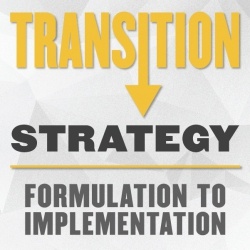Article
Crossing the Chasm: Leadership nudges to help transition from strategy formulation to strategy implementation. Tawse, A., Partick, V., & Vera, D.
Journal
Business Horizons, (2019), Volume 62, 249-257
Reviewer
Dr. Brady Brewer, Assistant Professor
Summary
Formulating a strategy is something many CEO’s spend a significant amount of time on. However, the implementation of that strategy is where a great deal of management falls short. Borrowing an analogy from the great game of football, a team that has the perfect playbook and game plan but cannot execute the plays or game plan will not have much success on the field. In this paper, the authors explore why this proverbial chasm is too deep for a lot of managers to cross, causing the company to stumble on the implementation, or worse, never start the implementation of the strategic plan. To study this phenomenon, the authors looked at the intersection of management and psychology to examine if there is a link that may help provide us with nudges, which are behavioral modifications that may modify the manager’s approach to help ensure successful implementation of the strategic plan from beginning to finish.
The authors identify six nudges that can help with successful implementation:
1. Remove the distraction to plan
2. Develop implementation intentions
3. Use verbal framing
4. Highlight the end game
5. Leverage a crisis
6. Celebrate small wins
Some of these nudges are not exactly intuitive at first glance, so let’s dive a little deeper into each of them. The first three nudges are centered on staying on task in the early stages of implementation. The first, removing the distraction to plan, is referencing a manager’s inclination to keep planning, even if strategic goals have already been agreed upon. The authors find that managers enjoy planning so much, they keep doing it if given the chance. They suggest once a strategic plan is agreed upon, hold “implementation only” meetings so that more strategic development does not distract from the end game that’s already been set. The second, developing implementation intentions, involves creating specific goals through if/then scenarios. These goals help workers focus on what the strategic plan is trying to accomplish and helps to provide a road map for successful implementation. The third nudge, verbal framing, addresses how communicating clearly with workers and stakeholders can go a long way in motivating them to achieve the desired outcome(s). While this nudge may sound cliché, it is crucial to choose the right words to ensure that everything stays on track.
The last three nudges address the desire to keep the planning phase of the strategic plan in order to keep workers in the implementation phase. The fourth nudge, highlighting the end game, builds upon several of the earlier nudges. This helps empower workers and management alike by allowing them to see the positive outcomes that may come from successful implementation. The authors suggest highlighting the benefit of the strategic plan to the customers. For example, highlighting how the product helps improve the lives of the customers can be uplifting and help motivate workers to keep on track. The fifth nudge, leveraging a crisis, says that creating a sense of urgency helps workers stay on task. If workers feel that a project is vital to the longevity of the company, more attention is paid to the project and success rates increase. Finally, the sixth nudge is to celebrate the small wins. This nudge may be the most straight forward. Celebrating the small wins helps to highlight the progress the company is making and hopefully keep workers motivated by showing them the fruits of their labor.
What this means for Food and Agricultural Business
In the ever-changing world of business, companies are constantly reinventing themselves to closer align with customer demands or to streamline certain processes within the company. Agricultural businesses are not immune to this. In fact, in my interactions with agribusinesses, most say they are “behind the game” in regard to technology adoption, analytics or some other strategy they feel a competitor is using. Obviously, not all agribusinesses are playing catchup, but this does highlight the fact that agriculture is experiencing change in how different parts of the supply chain conduct business. This is leading to a lot of companies reassessing their strategies and implementing new plans on a continual basis. In addition to current companies striving to keep pace, new companies and startups trying to gain market share are abound.
In this fast-paced market, it is imperative that companies not only have a winning strategy, but are able to execute this strategy as well. This is the chasm this research addresses. Breaking that cycle of continual planning to create an environment that fosters successful implementation is key. Seeing a strategy through to the end should be the goal of every manager. Then, even when everyone is ready to execute, in my experience, this implementation is where a lot of companies fall short. The playbook is in place, but the coordination needed to execute is not present. It is often the case that new strategies may change worker roles and activities; overcoming this inertia can be difficult. Workers have years of training engrained to do tasks a certain way that we are now asking them to either change, or in the extreme, entirely forget. Keeping the train on the tracks as companies implement new strategies is no small feat and takes due diligence from management so that momentum is not lost.
Now, this does not mean that current strategies should never be reassessed mid-stream. In an environment where disruption and change are the norm, strategies need to be flexible and management needs to understand when a current strategy is not working. However, what these authors emphasize is that distractions and the desire to stay in the planning loop should never prohibit a potential strategy from coming to fruition.




